The return from winter break brought a highly anticipated FAWSL match between Chelsea Women and Reading Women. Chelsea, over the break, have acquired world-class striker Sam Kerr from the Chicago Red Stars. After analysis, we can see that Kerr made an immediate impact on the squad and will almost assuredly bring an increased attacking dynamic to the team as the season continues. Reading were tasked with employing tactics effective enough to overcome a very strong Chelsea starting eleven.
Would Reading be able to negate and overcome the recently equipped home team or would Chelsea prove themselves to be a newly defined league powerhouse? This tactical analysis will look at exactly how it happened.
Line ups
Chelsea (4-4-2): Berger, Bright, Ingle, England, Ji, Reiten, Eriksson, Mjelde, Kerr, Spence, Andersson.
Reading (4-4-2): Moloney, Pacheco, Williams, James, Allen, Eikeland, Moore, Chaplen, Potter, Rowe, Howard.
Reading: high press
The instant the opening whistle rang across the pitch, Reading employed an aggressive full team press. Reading set out to allow Chelsea absolutely no time on the ball and restricted space and passing options while doing so.
Reading did this by pushing players high up the pitch in a player to player marking scheme. At some points the Reading players even had numerical superiority over the Chelsea players in the relevant area. Reading first sought to force Chelsea play out wide by tightly marking and out-numbering central Chelsea pivot players. Once Chelsea circulated the ball to a flank, Reading immediately closed down all nearby players with player to player marking in an attempt to win the ball back.
The first goal kick of the match gave us a quick glimpse of how Reading would approach their out of possession tactics. Below we can see that Reading have retained their 4-4-2 shape and have aggressively pushed their forward and midfield lines up the pitch. Forward players Amalie Eikeland and Brooke Chaplan have aligned as close to the Chelsea centre-backs as possible (who are in the 18-yard box).
The Reading midfield diamond also pushes up, with the central midfielders covering both central space and eliminating Ji So-yun and Sophie Ingle as safe passing options. The Reading outside midfielders (Remi Allen and Angharad James) remain in the halfspaces to both maintain numerical superiority in the central area and encourage passes out wide to the Chelsea fullbacks.
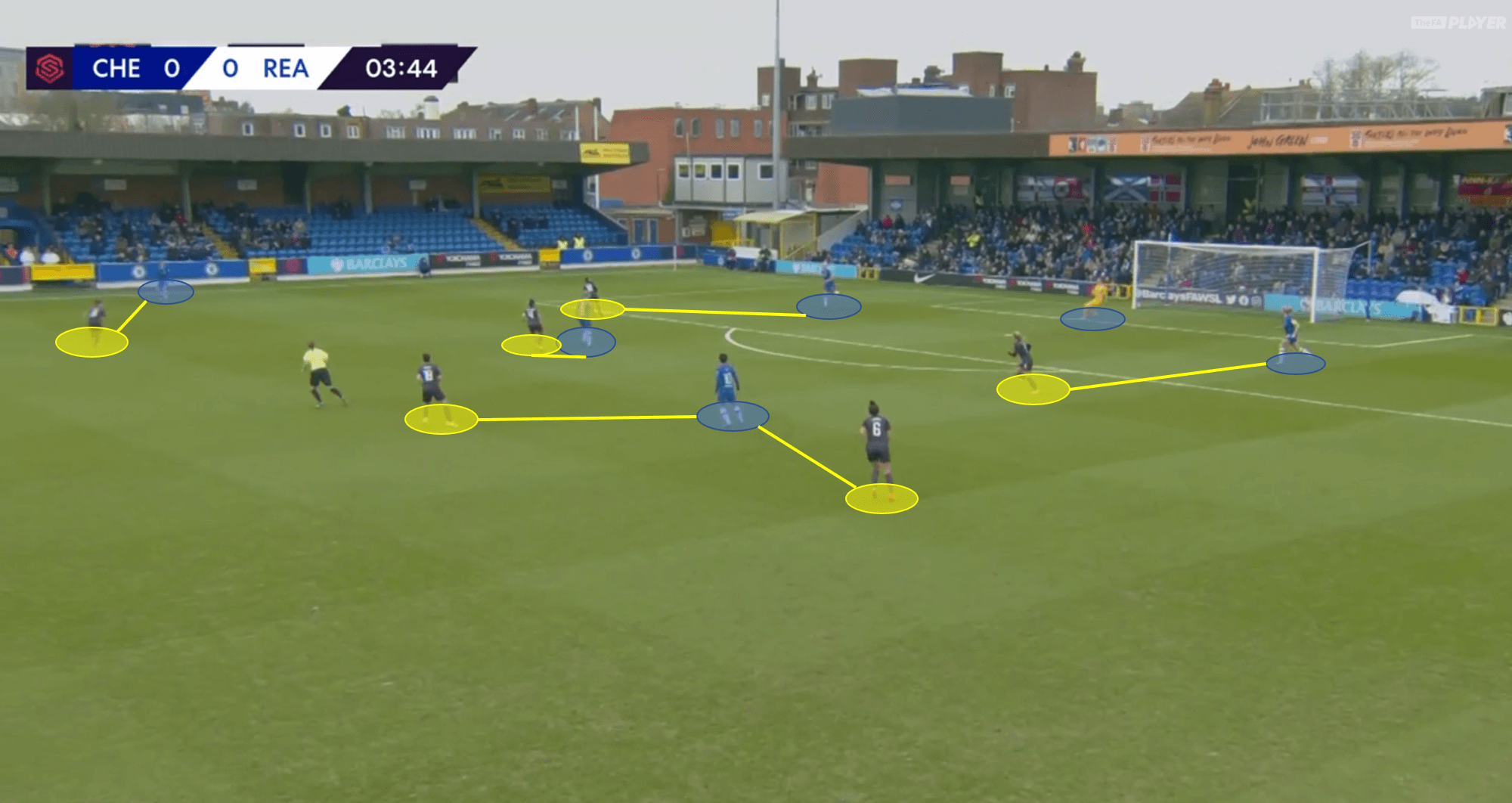
Once Chelsea circulated the ball to the flank, Reading transitioned into an intense player to player press. In the sixth minute we see the ball circulated to Chelsea left-back Jonna Andersson. As the ball moves to Andersson’s feet, the Reading central midfielders Fara Williams and Jade Moore shift horizontally to mark Ji and Guro Reiten. Simultaneously, Reading forward Eikeland, shifts to a position that allows her to both mark Chelsea centreback Magdalena Eriksson and create a cover shadow, preventing access to the goalkeeper Ann-Katrin Berger.
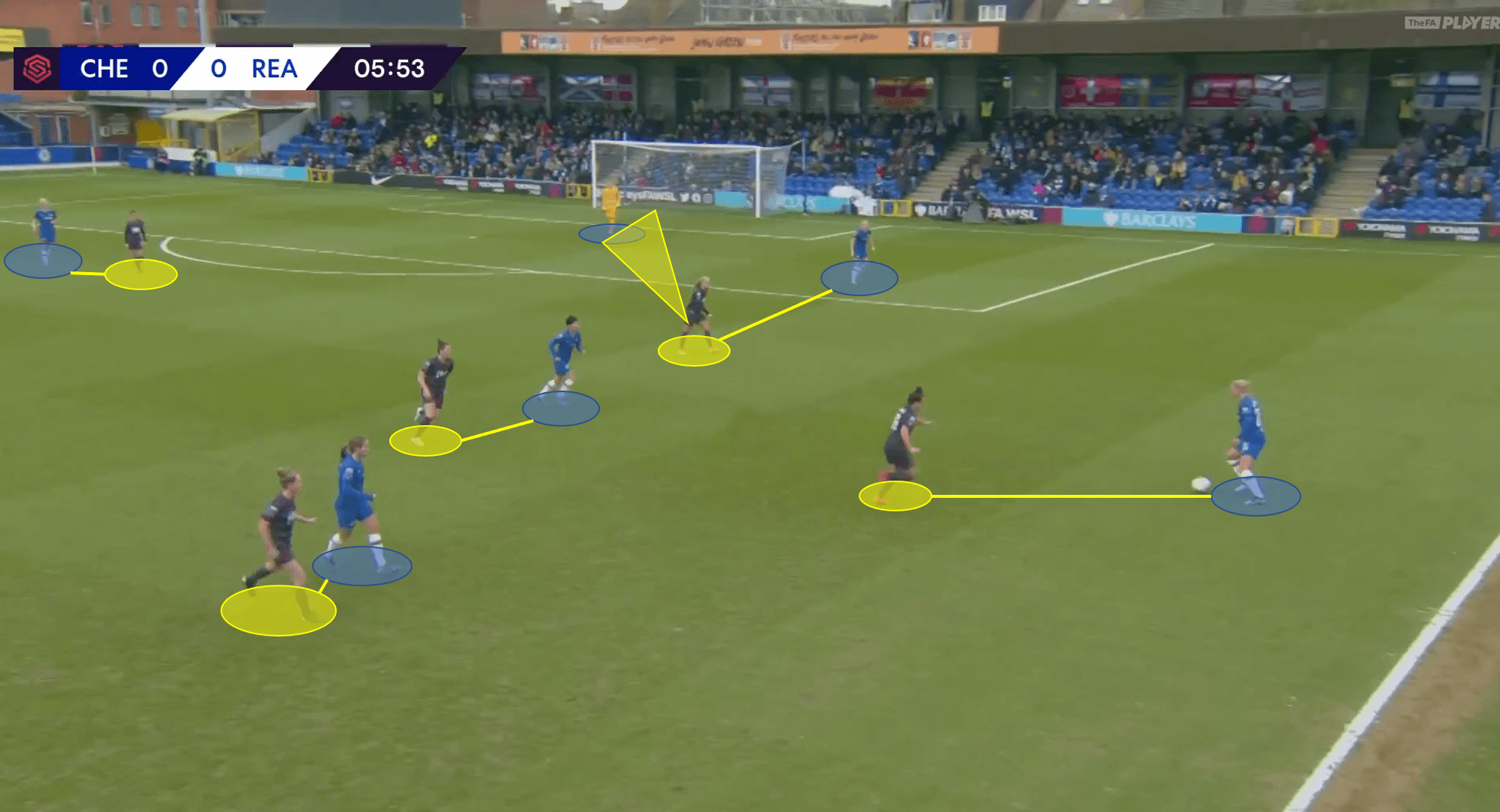
Reading took the lead with a goal resulting from a successful press on the right flank. Below, Reading are once again enacting a player-to-player press. Although, this time the Reading players are able to create cover shadows preventing vertical access and create a numerical overload in the immediate area. As we can see below, Chelsea have a potential opportunity to escape horizontally through ball-far centreback Millie Bright or right-back Maren Mjelde. Reading prevent this escape by keeping immediate and intense pressure on the ball carrier.
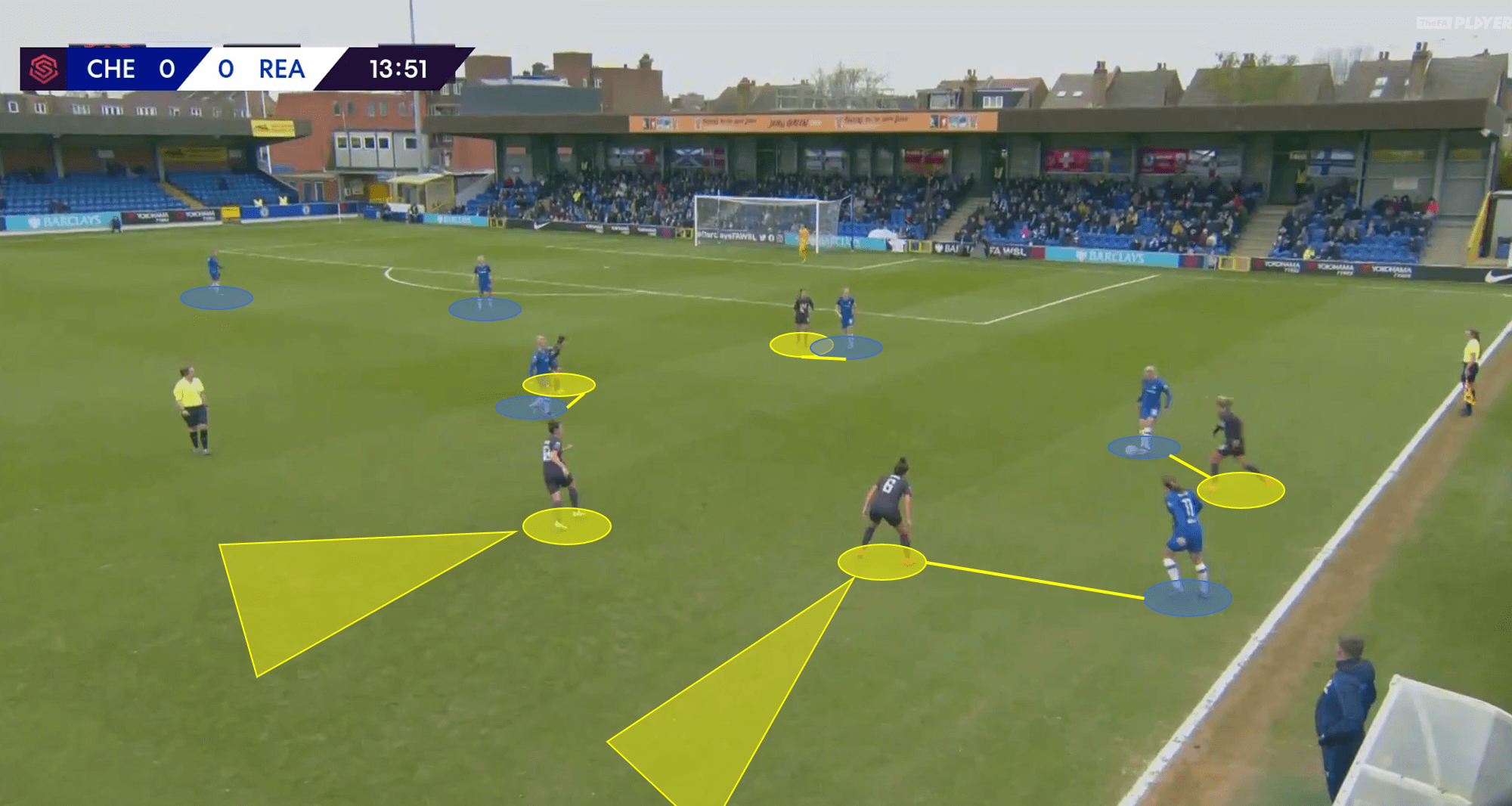
After Reading scored the first goal of the game, it looked as though Chelsea were in for a long and physical match. Not more than two minutes later, the Reading goalkeeper Grace Moloney was sent off for taking out Sam Kerr and preventing a goal-scoring opportunity. Reading were now unable to effectively inflict an intense press. The balance of the game changed immediately.
Chelsea: progression to the attacking third
When in possession, Chelsea utilized a positional play structure in the flanks and halfspaces to progress to the attacking third. This was done by positioning three lines of players in a diamond shape who referenced the location of the Reading midfield line. Once this diamond was in place, Chelsea additionally sought to push a player high up the flank to create a 2v1 situation against the Reading fullback.
Chelsea made this even more difficult to defend against by also employing positional rotations. The players in each position would change each time the diamond was created, but the positional principles would remain. Firstly, the base of the diamond would align in the halfspace and about ten metres in front of the Reading midfield line. Simultaneously, two Chelsea players would arrive on each side of the Reading midfielders. The Chelsea midfielder on the flank would position herself almost on the touchline but in front of the Reading line. The other Chelsea midfielder would move to the central channel and just behind the Reading midfielders. Lastly, the top of the Chelsea diamond positioned herself in the halfspace and a few metres in front of the Reading defensive line.
With this diamond in place, Chelsea typically had a situational 4v3 overload against the sliding Reading midfield line. Chelsea’s attacking tactics did not end there. Chelsea also pushed one more player higher up the touchline just in front of the Reading defensive line. This aided Chelsea in creating a 2v1 situation against the Reading fullback. By implementing this positional structure, Chelsea were able to create many chances on goal.
Below, we see Chelsea have implemented a positional diamond on the left flank. The base of the diamond, Ericsson, plays the ball to the wide midfielder who in this scenario is Ji. Ji’s possession draws the Reading midfield line towards her and creates space behind for the Chelsea player at the top of the diamond (Reiten). Ji then moves the ball to Reiten, who receives on the half-turn and in an advantageous 2v1 situation with Andersson against Reading right-back Rachel Rowe. This leads to a chance on goal.
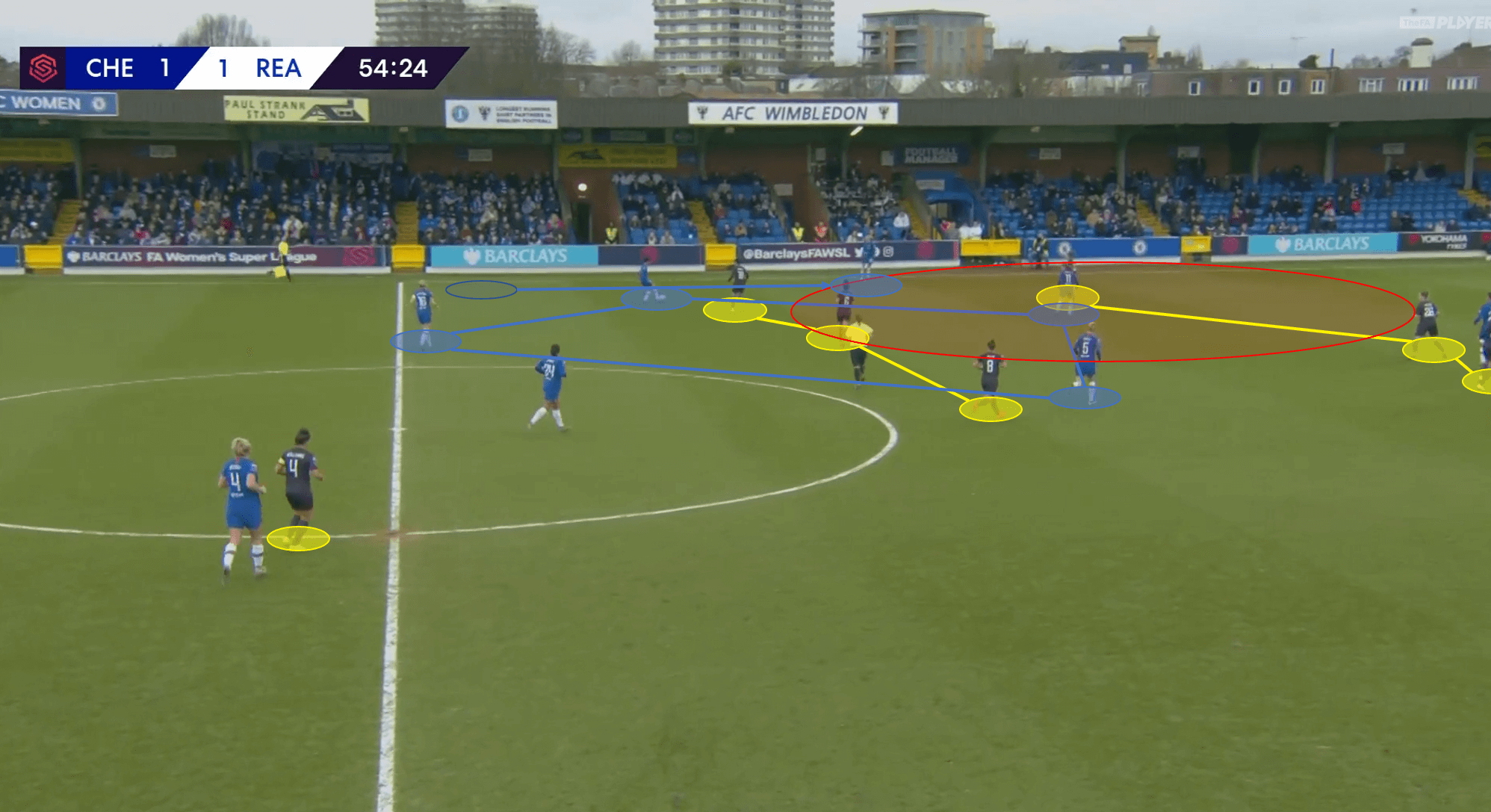
Not four minutes later, the same positional scenario plays out, but with an interchange in personnel within the positional structure. This time, Ji occupies the base of the diamond in the halfspace. Positioned on the flank and in front of the Reading midfield line is left-back Andersson. Ingle, once again positions herself in the central channel and aims to occupy space behind the midfield line. Sam Kerr drifts over to create the top of the diamond while Reiten moves to the touchline and on to the same horizontal line as Kerr.
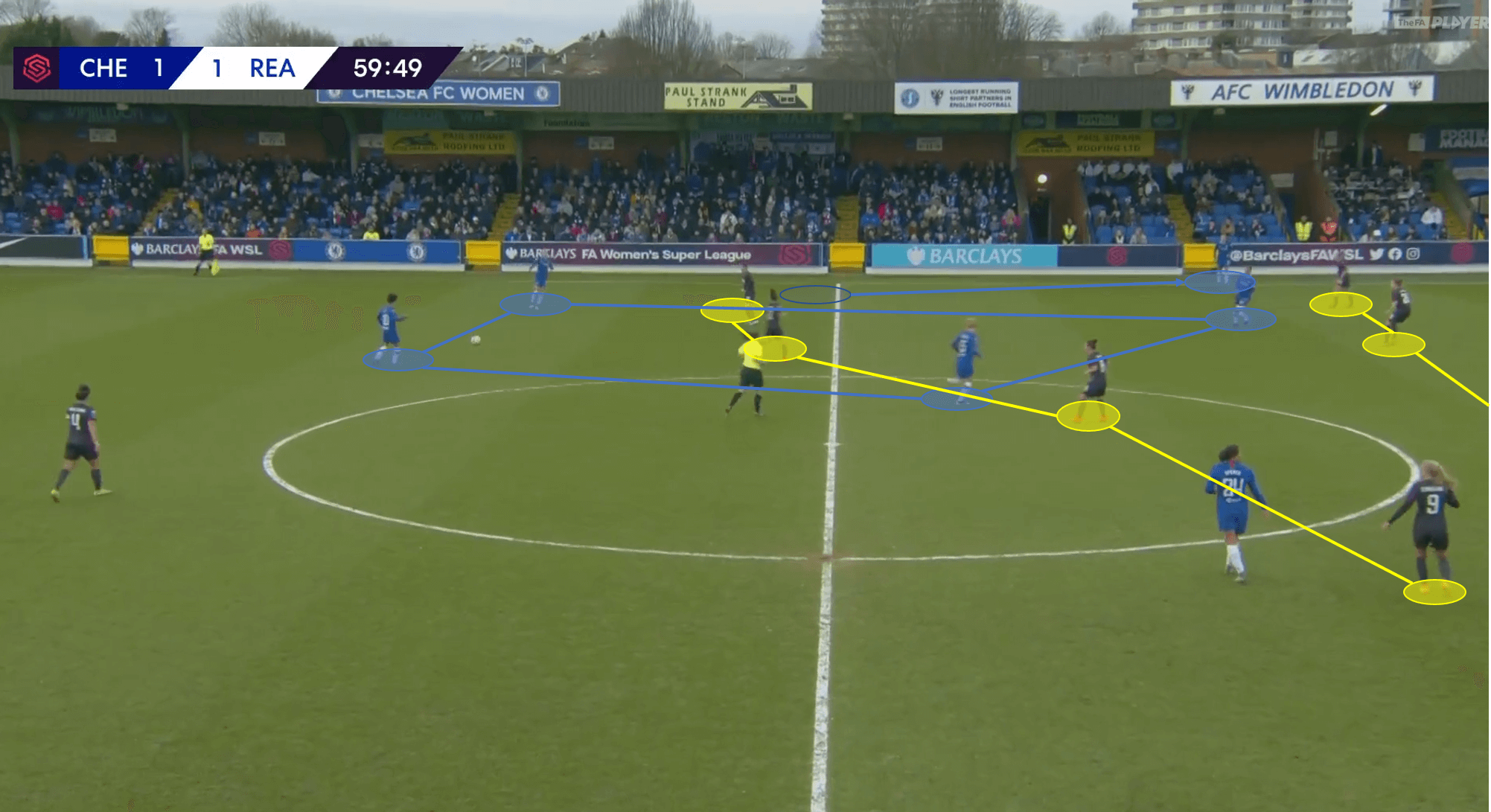
Once again, Chelsea progress to the attacking third. It should be noted that in this specific situation a 2v1 against the Reading fullback is not created because Reading centreback Sophie Howard has been encouraged to closely mark Kerr.
Chelsea allocated this positional diamond to reach the attacking third fairly consistently.
Chelsea: Sam Kerr
Chelsea’s acquisition of Sam Kerr from the Chicago Red Stars over the winter break sent shockwaves through the FAWSL. Kerr, an Australian international, is widely considered to be one of the top players in the women’s game. In her last three seasons in the NWSL she led the league in goals scored. Her arrival into the FAWSL brings a high level of anticipation and excitement. One game into her tenure with Chelsea, we saw a glimpse of her attacking prowess.
By using blindside movements and off the ball runs to manipulate Reading defenders, Kerr was able to create chances on goal herself as well as create space and goal-scoring opportunities for her teammates.
Kerr looked to be right at home within the Chelsea squad from the start of the game. Chelsea’s midfield quartet of Ingle, Ji, Reiten and Spence give opposition defenders plenty to focus on throughout a match. Kerr takes advantage of defender’s split attention by primarily positioning herself on the blindside of her marking defender.
This blindside positioning creates many problems for any defender. The defender must now maintain focus on the play in front of her, due to the dangerous attacking ability of the Chelsea midfield, while also focusing on the off the ball movement of Kerr. This proves to be almost impossible for most players.
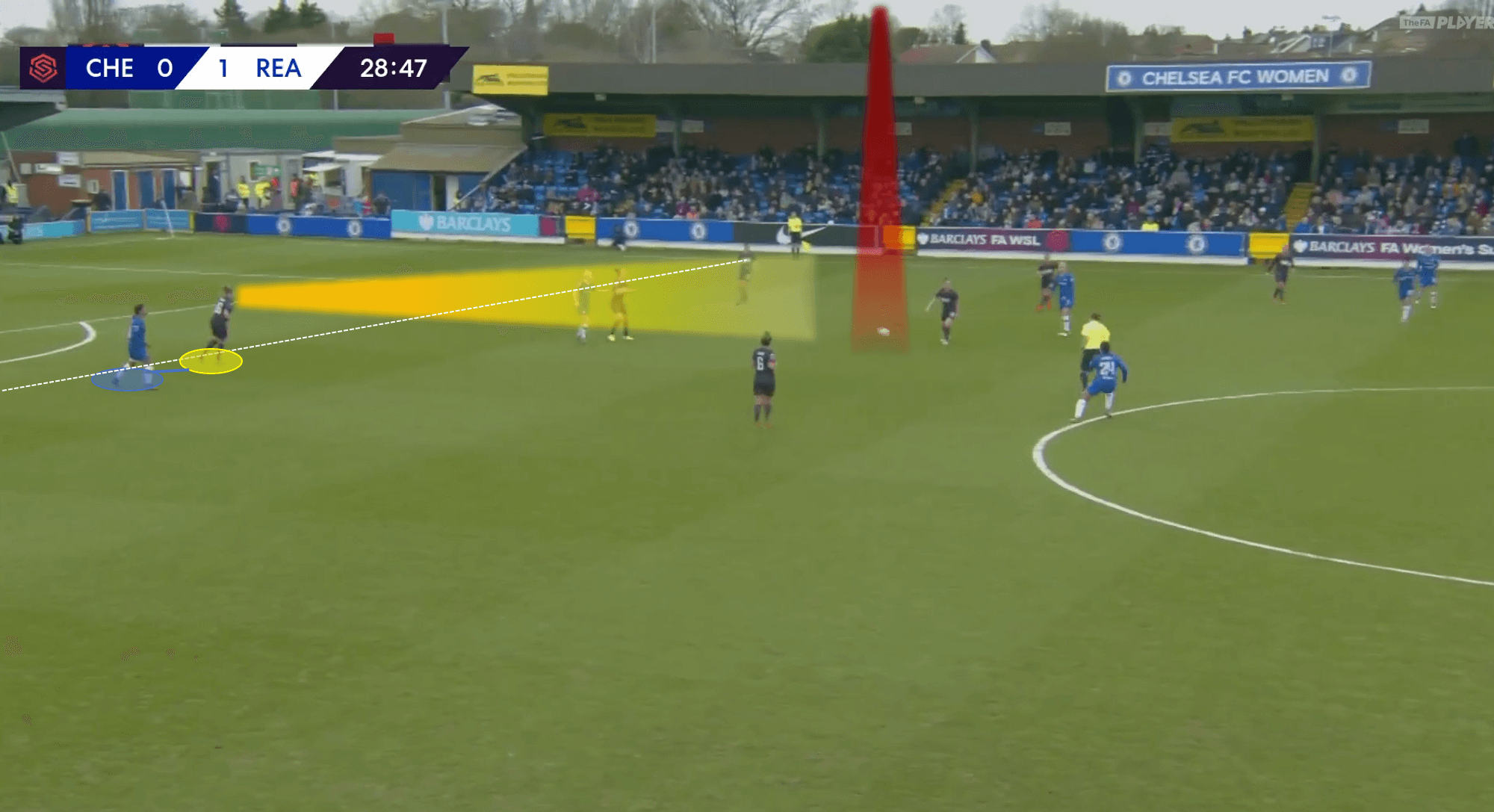
Below, we see a moment when Reading’s Howard has maintained her vision on the charging Chelsea left-back Mjelde. Kerr maintains her positioning on Howard’s blindside and is poised to make a sprinting run behind. Mjelde places a through ball into the gap between the Reading centre-back and right-back. As the ball travels Kerr is already behind Howard and ready to receive in dangerous space.
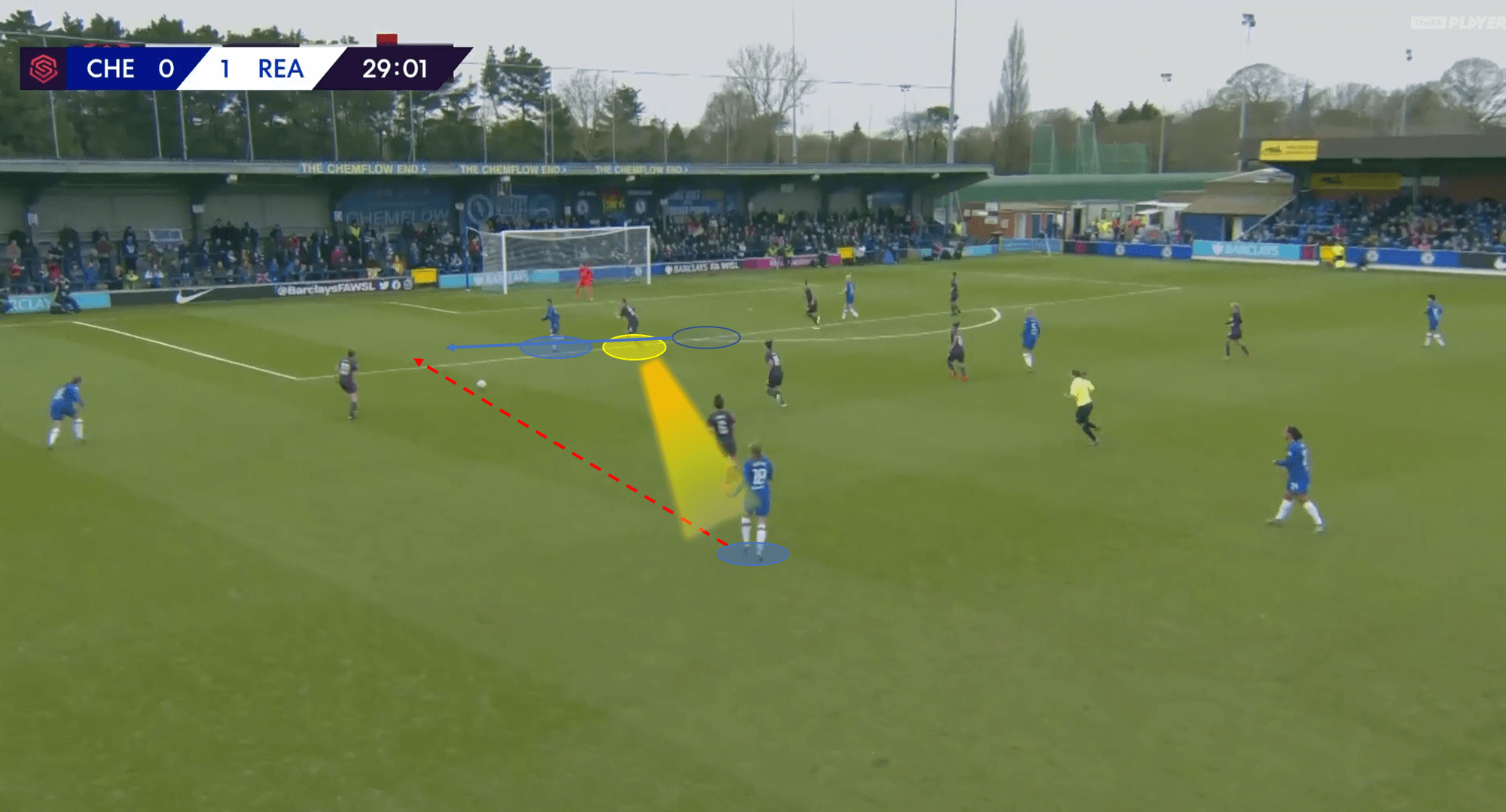
Kerr utilized and executed this positioning and movement many times throughout the match.
Kerr also employed clever off the ball runs to manipulate the positioning of the Reading defensive line and create space for teammates. Chelsea’s first goal of the match was created from a Kerr off the ball run.
In this moment, Bethany England has received the ball with her body facing upfield on a Chelsea counterattack. As England receives the ball, Kerr makes a diagonal run from her central position. Kerr’s run is done with the intention of removing the Reading central defender from the centre area. England is then left to either pass the ball forward into the path of Kerr or to cut in centrally and attempt to penetrate to towards the Reading goal.
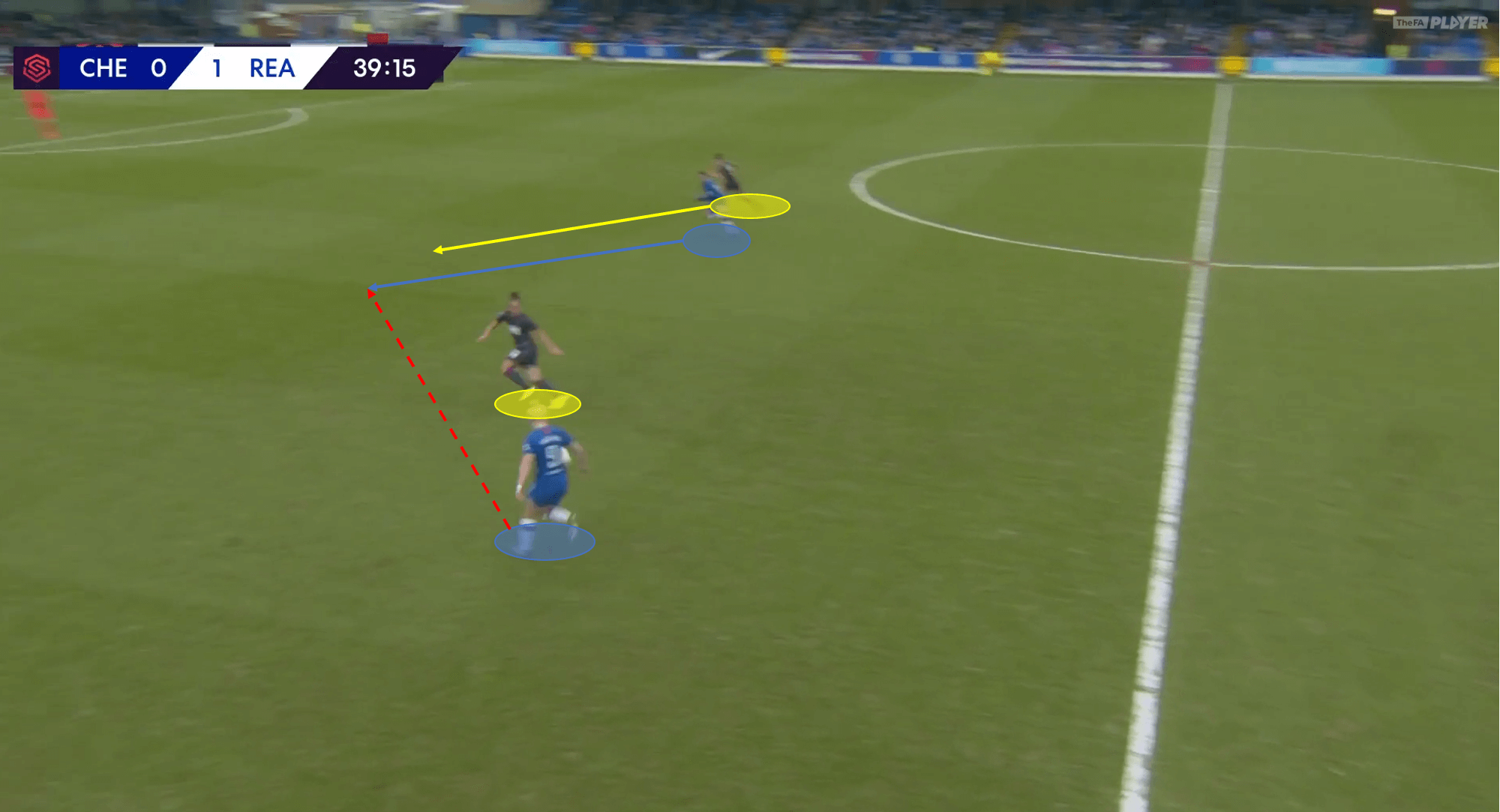
England opts to pass the ball into the path of Kerr. Kerr receives the ball well aware that England is now moving towards a completely vacant central channel. Kerr executes a perfect backheel pass to place the ball into the path of the streaking England. England penetrates forward and eventually smashes the ball into the back of the net.
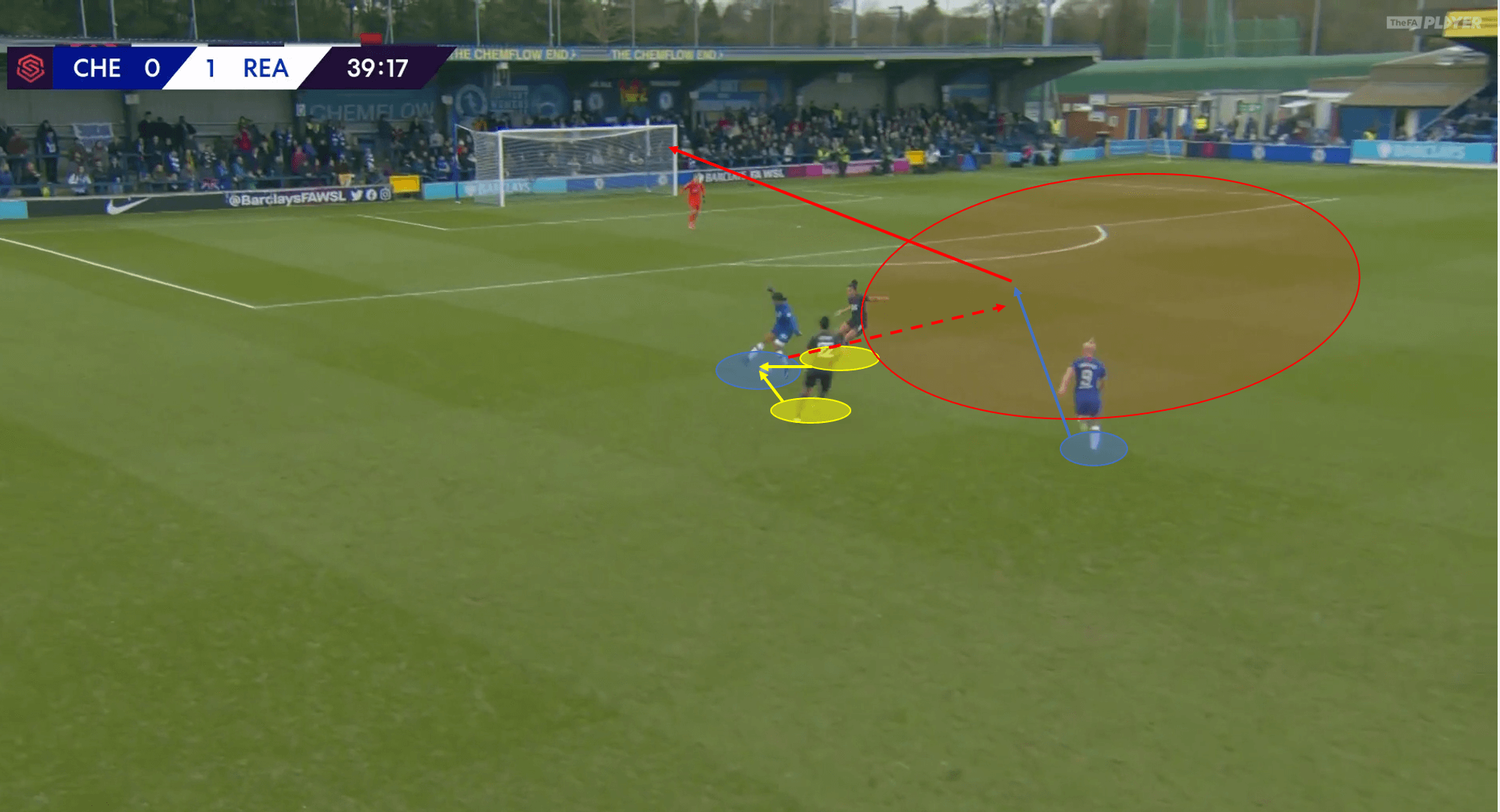
Although Kerr has been with the club for less than a month, her effect on Chelsea’s attacking tactics can be immediately felt. Chelsea will no doubt become more and more dangerous as Kerr acclimates to the squad.
Conclusion
Although Reading were able to take control of the match before their red card, Chelsea eventually instituted their dynamic and effective attacking tactics to walk of the pitch with three points. Reading will be disappointed knowing that a win would have moved them into the top four. Chelsea remain just outside the top two, but with the addition of Sam Kerr, carry a strong sense of optimism moving forward.





Comments